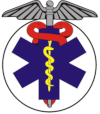Advanced Cardiovascular Life Support
About

Laerdal SimMan Patient Simulator provides a realistic training environment.
Course Description
Advanced Cardiovascular Life Support (ACLS) is a video-based, Instructor-led, advanced course, building on the foundation of basic life support (BLS) skills. It emphasizes the importance of continuous, high-quality CPR and takes healthcare provider training to the next level- highlighting the importance of high-performance team dynamics and communication, systems of care, recognition and intervention of cardiopulmonary arrest, immediate post-cardiac arrest, acute dysrhythmia, stroke, and acute coronary syndromes.
The Heart and Stroke Foundations ACLS Course offers:
- The latest resuscitation science for improved patient outcomes
- Realistic scenarios, simulations, and animations depicting rescuers, teams, and patients
- Course and content flexibility for Heart and Stroke Foundation Instructors and students, including adaptability to local protocols
Course Overview
Scientific evidence has pointed the way toward better content, while educational research has led to improved design of the Advanced Cardiovascular Life Support (ACLS) Provider Course. Both the design and the content of the Heart and Stroke Foundation ACLS Provider Course are evidence based.
The ACLS Provider Course emphasizes 3 major concepts:
- The crucial importance of high-quality cardiopulmonary resuscitation (CPR) to patient survival
- The integration of effective basic life support (BLS) with ACLS interventions
- The importance of effective team interaction and communication during resuscitation
The course is designed to give students the opportunity to practice and demonstrate proficiency in the following skills used in resuscitation:
- Systematic approach
- High-quality BLS
- Airway management
- Rhythm recognition
- Defibrillation
- Intravenous (IV)/intraosseous (IO) access (information only)
- Use of medications
- Cardioversion
- Transcutaneous pacing
- Team dynamics
Students will practice the application of these and other skills in simulated cases and will practice both Team Leader and team member roles.
Intended Audience
The Heart and Stroke Foundation’s ACLS Course is designed for healthcare professionals who either direct or participate in the management of cardiopulmonary arrest or other cardiovascular emergencies. This includes personnel in emergency response, emergency medicine, intensive care, and critical care units such as physicians, nurses, and paramedics, as well as others who need an ACLS course completion card for job or other requirements.
It is highly recommended that only those who will use the skills of ACLS within their scope of practice take the ACLS Course. All students who meet the prerequisites and successfully pass the ACLS course will receive a course completion card. Receipt of a course completion card does not grant permission to practice the skills learned.
Prerequisites
Providers who take the full ACLS Course, or ACLS Renewal Course, must have a current Heart and Stroke Foundation BLS course completion card, complete the mandatory Pre-course Self-Assessment and be proficient in the following:
- Performing high-quality BLS skills through the use of the 2015 Guidelines Update for CPR and ECC
- Reading and interpreting electrocardiograms (ECGs) – Be able to identify – on a monitor and paper tracing – rhythms associated with bradycardia, tachycardia with adequate perfusion, tachycardia with poor perfusion, and pulseless arrest. These rhythms include but are not limited to:
- Normal sinus rhythm
- Sinus bradycardia
- Type I second-degree AV block
- Type II second-degree AV block
- Third-degree AV block
- Sinus tachycardia
- Supraventricular tachycardias
- Ventricular tachycardia
- Asystole
- Ventricular fibrillation
- Organized rhythm without a pulse
- Demonstrate a basic understanding of the essential drugs used in:
- Cardiac arrest
- Bradycardia
- Tachycardia with adequate perfusion
- Tachycardia with poor perfusion
- Immediate post–cardiac arrest care
Students are given direction on how to access the Student website in their ACLS Provider Manual. The student website provides important supplementary information and videos, as well as a link to the Precourse Self- Assessment. The mandatory Precourse Self-Assessment requires a passing score of 70% or higher to print the certificate. Students can take the Precourse Self-Assessment as many times as needed to achieve a passing score.

You must be logged in to post a comment.